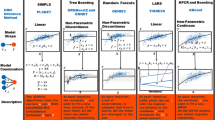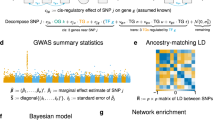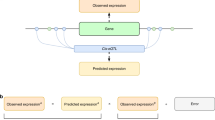Abstract
A key goal of biology is to construct networks that predict complex system behavior. We combine multiple types of molecular data, including genotypic, expression, transcription factor binding site (TFBS), and protein–protein interaction (PPI) data previously generated from a number of yeast experiments, in order to reconstruct causal gene networks. Networks based on different types of data are compared using metrics devised to assess the predictive power of a network. We show that a network reconstructed by integrating genotypic, TFBS and PPI data is the most predictive. This network is used to predict causal regulators responsible for hot spots of gene expression activity in a segregating yeast population. We also show that the network can elucidate the mechanisms by which causal regulators give rise to larger-scale changes in gene expression activity. We then prospectively validate predictions, providing direct experimental evidence that predictive networks can be constructed by integrating multiple, appropriate data types.
This is a preview of subscription content, access via your institution
Access options
Subscribe to this journal
Receive 12 print issues and online access
$209.00 per year
only $17.42 per issue
Buy this article
- Purchase on Springer Link
- Instant access to full article PDF
Prices may be subject to local taxes which are calculated during checkout


Similar content being viewed by others
References
Kulp, D.C. & Jagalur, M. Causal inference of regulator-target pairs by gene mapping of expression phenotypes. BMC Genomics 7, 125 (2006).
Lum, P.Y. et al. Elucidating the murine brain transcriptional network in a segregating mouse population to identify core functional modules for obesity and diabetes. J. Neurochem. 97 (Suppl. 1), 50–62 (2006).
Mehrabian, M. et al. Integrating genotypic and expression data in a segregating mouse population to identify 5-lipoxygenase as a susceptibility gene for obesity and bone traits. Nat. Genet. 37, 1224–1233 (2005).
Schadt, E.E. et al. An integrative genomics approach to infer causal associations between gene expression and disease. Nat. Genet. 37, 710–717 (2005).
Rual, J.F. et al. Towards a proteome-scale map of the human protein-protein interaction network. Nature 437, 1173–1178 (2005).
Nielsen, J. & Oliver, S. The next wave in metabolome analysis. Trends Biotechnol. 23, 544–546 (2005).
Rajagopalan, D. & Agarwal, P. Inferring pathways from gene lists using a literature-derived network of biological relationships. Bioinformatics 21, 788–793 (2005).
Brem, R.B. & Kruglyak, L. The landscape of genetic complexity across 5,700 gene expression traits in yeast. Proc. Natl. Acad. Sci. USA 102, 1572–1577 (2005).
Brem, R.B., Yvert, G., Clinton, R. & Kruglyak, L. Genetic dissection of transcriptional regulation in budding yeast. Science 296, 752–755 (2002).
MacIsaac, K.D. et al. An improved map of conserved regulatory sites for Saccharomyces cerevisiae. BMC Bioinformatics 7, 113 (2006).
Lee, T.I. et al. Transcriptional regulatory networks in Saccharomyces cerevisiae. Science 298, 799–804 (2002).
Zhu, J. et al. An integrative genomics approach to the reconstruction of gene networks in segregating populations. Cytogenet. Genome Res. 105, 363–374 (2004).
Zhang, B. & Horvath, S. A general framework for weighted gene co-expression network analysis. Stat. Appl. Genet. Mol. Biol. 4, Article17 (2005).
Ghazalpour, A. et al. Integrating genetic and network analysis to characterize genes related to mouse weight. PLoS Genet. 2, e130 (2006).
Ravasz, E., Somera, A.L., Mongru, D.A., Oltvai, Z.N. & Barabasi, A.L. Hierarchical organization of modularity in metabolic networks. Science 297, 1551–1555 (2002).
Yvert, G. et al. Trans-acting regulatory variation in Saccharomyces cerevisiae and the role of transcription factors. Nat. Genet. 35, 57–64 (2003).
Chen, Y. et al. Variations in DNA elucidate molecular networks that cause disease. Nature 452, 429–435 (2008).
Hughes, T.R. et al. Functional discovery via a compendium of expression profiles. Cell 102, 109–126 (2000).
Deeds, E.J., Ashenberg, O. & Shakhnovich, E.I. A simple physical model for scaling in protein-protein interaction networks. Proc. Natl. Acad. Sci. USA 103, 311–316 (2006).
Palla, G., Derenyi, I., Farkas, I. & Vicsek, T. Uncovering the overlapping community structure of complex networks in nature and society. Nature 435, 814–818 (2005).
Guldener, U. et al. MPact: the MIPS protein interaction resource on yeast. Nucleic Acids Res. 34, D436–D441 (2006).
Ge, H., Liu, Z., Church, G.M. & Vidal, M. Correlation between transcriptome and interactome mapping data from Saccharomyces cerevisiae. Nat. Genet. 29, 482–486 (2001).
Jansen, R., Greenbaum, D. & Gerstein, M. Relating whole-genome expression data with protein-protein interactions. Genome Res. 12, 37–46 (2002).
Lee, I., Date, S.V., Adai, A.T. & Marcotte, E.M. A probabilistic functional network of yeast genes. Science 306, 1555–1558 (2004).
Lee, S.I., Pe'er, D., Dudley, A.M., Church, G.M. & Koller, D. Identifying regulatory mechanisms using individual variation reveals key role for chromatin modification. Proc. Natl. Acad. Sci. USA 103, 14062–14067 (2006).
Workman, C.T. et al. A systems approach to mapping DNA damage response pathways. Science 312, 1054–1059 (2006).
Zhu, J. et al. Increasing the power to detect causal associations by combining genotypic and expression data in segregating populations. PLOS Comput. Biol. 3, e69 (2007).
Tan, K., Shlomi, T., Feizi, H., Ideker, T. & Sharan, R. Transcriptional regulation of protein complexes within and across species. Proc. Natl. Acad. Sci. USA 104, 1283–1288 (2007).
Ogawa, N., DeRisi, J. & Brown, P.O. New components of a system for phosphate accumulation and polyphosphate metabolism in Saccharomyces cerevisiae revealed by genomic expression analysis. Mol. Biol. Cell 11, 4309–4321 (2000).
Ronald, J., Brem, R.B., Whittle, J. & Kruglyak, L. Local regulatory variation in Saccharomyces cerevisiae. PLoS Genet. 1, e25 (2005).
Giots, F., Donaton, M.C. & Thevelein, J.M. Inorganic phosphate is sensed by specific phosphate carriers and acts in concert with glucose as a nutrient signal for activation of the protein kinase A pathway in the yeast Saccharomyces cerevisiae. Mol. Microbiol. 47, 1163–1181 (2003).
Chen, X.J. Sal1p, a calcium-dependent carrier protein that suppresses an essential cellular function associated with the Aac2 isoform of ADP/ATP translocase in Saccharomyces cerevisiae. Genetics 167, 607–617 (2004).
Deutschbauer, A.M. & Davis, R.W. Quantitative trait loci mapped to single-nucleotide resolution in yeast. Nat. Genet. 37, 1333–1340 (2005).
Sinha, H., Nicholson, B.P., Steinmetz, L.M. & McCusker, J.H. Complex genetic interactions in a quantitative trait locus. PLoS Genet. 2, e13 (2006).
Pe'er, D., Regev, A., Elidan, G. & Friedman, N. Inferring subnetworks from perturbed expression profiles. Bioinformatics 17 (Suppl 1), S215–S224 (2001).
Ong, I.M., Glasner, J.D. & Page, D. Modelling regulatory pathways in E. coli from time series expression profiles. Bioinformatics 18 (Suppl 1), S241–S248 (2002).
Acknowledgements
Work at Princeton was supported by National Institute of Mental Health grant R37 MH059520 and a James S. McDonnell Foundation Centennial Fellowship to L.K., and Center grant P50GM071508 from the National Institute of General Medical Science to the Lewis-Sigler Institute. We thank J. Whittle for generating GPA1 allele swap data, S. Iyer for performing some of the deletion strain validation experiments and A. Deutschbauer (Lawrence Berkeley National Laboratory) for providing us with the MKT1 allele swap strain YAD350. We would also like to thank R. Ireton for her careful reading and editing of this manuscript.
Author information
Authors and Affiliations
Contributions
E.N.S., B.D., R.B.B. and L.K. constructed and characterized the genetically modified yeast strains. J.Z., B.Z. and E.E.S. carried out the coexpression and Bayesian network analyses and performed bioinformatic analyses. E.N.S., B.D., R.B.B., L.K. and R.E.B. aided in the data analysis. All authors were involved in the study design and interpretation of the experimental results, and discussed the results and commented on the manuscript. J.Z., B.Z. and E.E.S. designed the study, developed methods, analyzed the data and wrote the paper.
Corresponding author
Ethics declarations
Competing interests
J.Z., B.Z. and E.E.S. work for Merck and own stock in the company.
Supplementary information
Supplementary Text and Figures
Supplementary Data, Supplementary Methods, Supplementary Figures 1–5 and Supplementary Tables 1–4 (PDF 10776 kb)
Rights and permissions
About this article
Cite this article
Zhu, J., Zhang, B., Smith, E. et al. Integrating large-scale functional genomic data to dissect the complexity of yeast regulatory networks. Nat Genet 40, 854–861 (2008). https://doi.org/10.1038/ng.167
Received:
Accepted:
Published:
Issue Date:
DOI: https://doi.org/10.1038/ng.167
This article is cited by
-
Integrated study of systemic and local airway transcriptomes in asthma reveals causal mediation of systemic effects by airway key drivers
Genome Medicine (2023)
-
An integrative multiomic network model links lipid metabolism to glucose regulation in coronary artery disease
Nature Communications (2021)
-
Downregulation of exhausted cytotoxic T cells in gene expression networks of multisystem inflammatory syndrome in children
Nature Communications (2021)
-
Identification of therapeutic targets from genetic association studies using hierarchical component analysis
BioData Mining (2020)
-
Fully automated web-based tool for identifying regulatory hotspots
BMC Genomics (2020)



